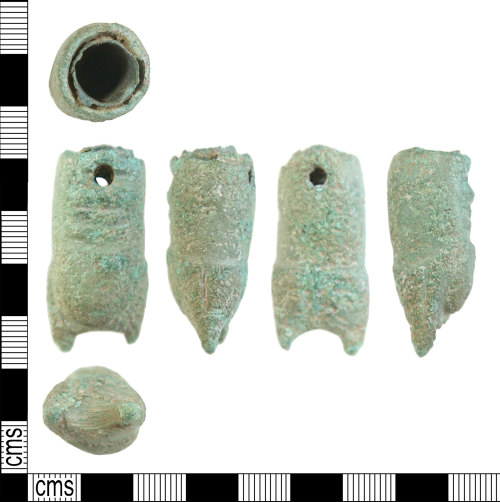
Rights Holder: Hampshire Cultural Trust
CC License: ![]()
Image use policy
Our images can be used under a CC BY attribution licence (unless stated otherwise).
SCEPTRE
Unique ID: HAMP-B2E301
Object type certainty: Possibly
Workflow
status: Published ![]()
An incomplete copper alloy socketed terminal or fitting of probable Roman date (AD 43-410) and of possible zoomorphic/ feline form. It has an old break across two projections (perhaps originally a loop or ears) at one end but is otherwise complete. The object is tubular in shape with the socket occupying roughly half of the length (with a depth of 16.2mm) while the rest of the object is solid; perhaps the solid end intended here to 'weight' the complete original object and give it balance. The object
The socketed section has two piercings opposite to each other at the edge. These measure c.3mm in diameter. To the inside of the socket is a sheet metal casing 0.6mm thick, with two piercings in line with those mentioned previously. This metal is of a different copper alloy, and grey-green/blue in colour. It slightly protrudes from the open end for c.9-10mm. The open end of the socket has some worn damage and measures 15.7x15.5mm in diameter. The walls are c.2mm thick and the internal diameter (inside the sheet casing) is 9.2mm. To one face of the socket there are three short but deep parallel transverse grooves c.11mm in length above the piercing, with a wider groove of simlar length across the piercing. These areas retain the original olive green coloured smooth patina of the object. There is otherwise no other decoration to the socket.
Above the socket is the solid section, and this is rather more oval in cross-section with a raised and slightly off-centre circular area in the centre on the face with the transverse grooves. Starting at the sides of the object and roughly half way up the circular area, a stepped groove runs around the back of the object. To the sides a vertical groove on either side extends upwards into the base of the truncated projections/ loop. At the reverse of the object there is a possible vertical groove from the loop to the stepped groove with two possible short diagonal groove to one side. However the object is very badly pitted and this area is badly obscured. There are two further short diagonal grooves at the base of the shorter projection on both faces of the object.
Between the two projections/ loop truncations (c.3 and 3.5mm in diameter) is a concave area max.5.2mm wide which retains the original smooth olive green coloured patina of the metal. The breaks on the projections appear to be relatively recent and are a bright mid-green in colour.
The object is otherwise a grey-blue green in colour and heavily pitted. It measures 38.2mm in length, 18.2mm in max.width (solid section) and 15.7mm in max.depth (socket). It weighs 29.59g.
No parallel has been found for this object. A date between the late Iron Age and medieval period is suggested based on the patination of the metal and the manufacture of the object. Adam Gwilt (Principal Curator of Prehistory, National Museum Wales) comments, 'I cannot identify it as a specific diagnostic artefact type of Bronze or Iron Age date. I'm wondering whether it could be a hilt or handle terminal, perhaps to something like a knife or vessel? And If so, is a Roman date a possibility? The break edges are tricky to interpret, as very worn and insubstantial - I suppose they may have continued to form a loop, and the internal surface between the ears seems fresh and grooved, which might be consistent with this idea. The distinct sidedness with one moulded and curved dome end is also perhaps a clue to the object perhaps having had upper/lower, or outer/inner sides. It would be interesting to know whether there was any iron/bronze or wood surviving inside the socket. Finally the distinct groove near the upper side perforation, with two concentric incised lines around, might perhaps suggest a rivet with a sizeable head - perhaps decorative?' (pers. comm. February 2018).
Sally Worrell, National Finds Adviser, comments 'I think this owl (or is it a cat!) is from a Roman sceptre handle. I don't know of a parallel, but owls were associated with Minerva' (pers. comm. February 2018).
Find of note status
This has been noted as an interesting find by the recorder.
Subsequent actions
Subsequent action after recording: Returned to finder
Chronology
Broad period: UNKNOWN
Subperiod from: Late
Period from: IRON AGE
Period to: MEDIEVAL
Date from: Circa 100 BC
Date to: Circa AD 1500
Dimensions and weight
Quantity: 1
Length: 38.2 mm
Width: 18.2 mm
Thickness: 15.7 mm
Weight: 29.59 g
Personal details
This information is restricted for your access level.
Other reference numbers
Other reference: Hampshire Cultural Trust Object Entry Form WINCM 602
Materials and construction
Spatial metadata
Region: South East (European Region)County or Unitary authority: Hampshire (County)
District: East Hampshire (District)
Parish or ward: Horndean (Civil Parish)
Spatial coordinates
4 Figure: SU7112
Four figure Latitude: 50.90311816
Four figure longitude: -0.99165686
1:25K map: SU7112
1:10K map: SU71SW
Grid reference source: Generated from computer mapping software
Unmasked grid reference accurate to a 10 metre square.
References cited
No references cited so far.
Similar objects

Find number: HAMP-72D5E7
Object type: BRIDLE BIT
Broadperiod: IRON AGE
An incomplete early to middle Iron Age (600 - 200 BC) copper alloy harness fitting, perhaps a bridle bit, consisting of an incomplete sub-cir…
Workflow: Awaiting validation![]()

Find number: WILT-31F504
Object type: UNIDENTIFIED OBJECT
Broadperiod: UNKNOWN
An incomplete copper alloy unidentified object, weighing 41.93g and measuring 40.28x(max)18.54x(max)16.34mm.
The object is solid at one end…
Workflow: Awaiting validation![]()

Find number: HAMP-CAE3DD
Object type: KNIFE
Broadperiod: ROMAN
A copper alloy Roman (AD 43-410) figurative knife handle in the form of a solid human male bust projecting above a trapezoidal socket.
The hea…
Workflow: Published![]()



